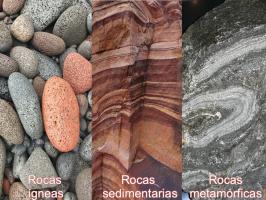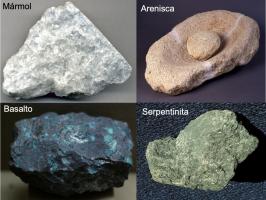Difference Between Minerals and Rocks
The minerals are any naturally occurring crystalline solid with a specific chemical formula. For example, quartz is a mineral formed by the combination of silicon and oxygen with the formula SiO2.
The rocks They are solid masses, formed by the mixture of minerals that maintain their composition. For example, granite is a rock made up of different proportions of quartz, feldspar, and mica minerals.
Both minerals and rocks are part of the earth's crust. Minerals are extracted from the rocks for a variety of uses.
| minerals | rocks | |
|---|---|---|
| Definition | Natural inorganic solid with ordered internal structure and defined chemical composition | Any solid mass of mineral matter |
| Composition | Crystals of combinations of oxygen, silicon, aluminum, iron, calcium, sodium, potassium and magnesium. |
minerals |
| training process | Crystallization | Fusion Solidification compaction Pressure |
| Guys | silicates carbonates oxides Sulfates sulphides halides |
Igneous rocks Sedimentary rocks Metamorphic rocks |
| examples | quartz (silica) Fluorite (calcium fluoride) graphite (carbon) Calcite (calcium carbonate) Aragonite (calcium carbonate) Trona (Sodium Carbonate) Halite (sodium chloride) Fluorite (calcium fluoride) Silvina (potassium chloride) Magnetite (iron oxide) Hematite (iron oxide) Corundum (aluminum oxide) Anorthite (calcium-aluminum silicate) Albite (sodium aluminum silicate) Feldspar (aluminum silicates) Muscovite (potassium aluminum silicate) Galena (lead sulfide) Pyrite (iron sulfide) Talc (magnesium silicate) Gypsum (calcium sulfate dihydrate) |
Limestone: composed of calcite mineral. Marble: limestone metamorphic rock. Salt rock: sedimentary rock composed of halite. Sandstone: sedimentary rock composed of fragments of quartz and other minerals. Basalt: igneous rock composed of magnesium and iron silicates. Granite: igneous rock made up of quartz, mica, and feldspar. Serpentinite: metamorphic rock composed of olivine, pyroxene, and chromite Quartzite: metamorphic rock of sandstone. Obsidian: glassy volcanic rock. |
minerals

In geology, a mineral is a naturally occurring inorganic solid that has a defined chemical structure that gives it a unique set of physical properties. Some human-produced materials, such as steel, are not considered minerals.
Minerals are formed through the process of crystallization. This process consists of the chemical union of molecules or ions to build an ordered and repetitive structure. For example, silicate minerals form tetrahedrons, while halite forms cubes.
There are minerals with the same composition with different crystalline forms. Calcium carbonate can form the mineral calcite, with a trigonal crystalline system. Instead, aragonite is the mineral found in pearls and the shells of some marine animals, with an orthorhombic crystalline system.
Physical properties of minerals
The physical properties of minerals allow us to identify them:
- primary properties: crystal form, gloss, color, stripe, hardness, cleavage and specific weight.
- secondary properties: magnetism, taste, touch, smell, elasticity, malleability, birefraction and chemical reaction with hydrochloric acid.
Mineral groups and examples
Nearly 4,000 minerals are known on Earth, a fraction of which are known as rock-forming minerals. Just eight elements make up the bulk of those minerals: oxygen, silicon, aluminum, iron, calcium, sodium, potassium, and magnesium.
Depending on their composition, minerals are classified into the following groups:
silicates: contain the elements oxygen and silicon, forming tetrahedra, such as quartz, olivine (magnesium/iron silicate), augite, biotite and garnet.
carbonates: composed of the carbonate ion like calcite and dolomite.
halides: are formed by anions of halogen elements (chlorine, fluorine, bromine and iodine), such as halite, fluorite and silvina.
oxides: contain the oxygen anion bound to one or more positive ions or cations, such as hematite, magnetite, and corundum.
sulphides: sulfur compounds with other metals such as galena (lead sulfide), pyrite (iron sulfide), chalcopyrite (copper sulfide), cinnabar (mercury sulfide).
Sulfates: compound of sulphate anion such as gypsum and barite.
native elements: minerals made up of a single element, such as gold, copper, diamond (made up of carbon), sulfur, silver and platinum.
rocks

Rocks are conglomerates of various materials, most of them made up of various minerals that maintain their properties. An exception is limestone sedimentary rock, which is made up of the mineral calcite.
Some rocks, such as obsidian and pumice, are not made up of minerals. These are volcanic rocks of non-crystalline vitreous substances. Carbon is the remains of solid organic compounds.
The process of rock formation is varied. Volcanic or igneous rocks are formed by the melting process of underground material and the solidification of magma and lava. Sedimentary rocks are formed by deposition and compaction. And by pressure and temperature metamorphic rocks are formed.
Rock types with examples
- Igneous rocksThey are composed almost entirely of silicate minerals. Examples of igneous rocks are diorite, andesite, and basalt.
- Sedimentary rocks: are derived from sediments that are cemented. Examples of sedimentary rocks are sandstone, shale, limestone, and coal.
- Metamorphic rocks: They are formed by great pressures and high temperatures on other rocks. Examples are marble, gneiss and quartzite.
You may also be interested in seeing:
- rock types
- Types of soils
References
Petersen, J.F., Sack, D., Gabler, R.E. (2017) Physical Geography 11 ed. Cengage Learning. USES
Tarbuck, E.J., Lutgens, F.K. (2005) Earth Sciences-An Introduction to Physical Geology 8to ed. Pearson Education. Madrid.


